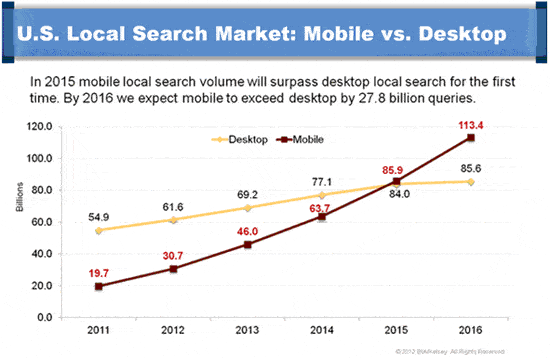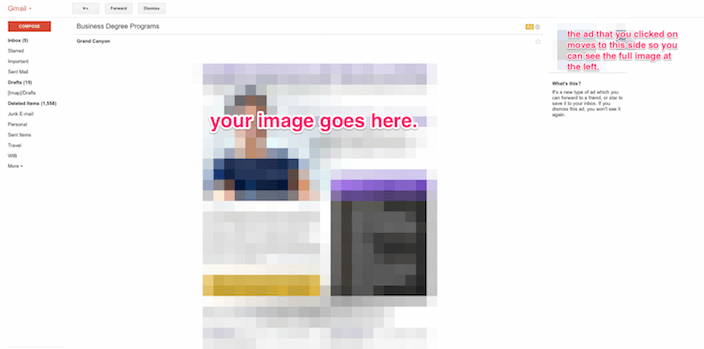Done right, PPC is one of the best ways to put the right traffic on the right post-click landing page.
Unfortunately, since PPC is such a great method of driving qualified, high-intent traffic to your post-click landing pages, it’s an incredibly competitive (and often expensive) way to get clicks.
Thankfully, there are a few unique tricks you can use to beat out the competition and get awesome PPC results. These tactics take a bit of extra work, but the results are worth it.
Here are 7 of my favorite tricks to driving more PPC post-click landing page traffic:
1. Optimize for mobile
In 2015, more Internet searches occurred on mobile than desktop. This landmark event represented a huge shift in how people are interacting with PPC advertising:

At this point, mobile ad spend is projected to top $100 billion in 2016 and should account for over 50% of all PPC ad spend in 2016. That means over half of your PPC clicks will take place on a mobile device.
Mobile advertising is a very different animal than desktop advertising, which means that the earlier you can adopt an effective mobile PPC strategy, the more clicks you will steal from your competition.
For example, on mobile, it’s important for your ads to place in positions 1-3. Otherwise, the odds of having your ad seen are fairly low (Google’s recent desktop update makes this important for desktop ads as well).
To see how your ads are performing on desktop versus mobile, try segmenting your data by device. This will give you a good feel for whether or not your PPC strategy works better or worse on mobile.
In addition to optimizing your PPC campaigns for mobile, it’s also critical to design your post-click landing pages to create a great mobile experience.
Responsive web design is not enough anymore; your post-click landing pages need to be designed for mobile users. If they aren’t, Google penalizes you, making it harder to get your ads into position 1-3 and reducing traffic to your post-click landing page.
Fortunately, a good post-click landing page platform like Instapage makes designing for mobile very easy.
At this point, PPC advertisers simply have to optimize for mobile. The search volume is too high to risk missing out on any mobile traffic.
So, if your mobile experience isn’t particularly inspiring, it’s time to get your act together.
2. Retargeting
People leave your post-click landing page without converting for a lot of reasons. And often, your bounce rate has little to do with your page or your offer.
Regardless of the specific reason, most of the time, when someone leaves your post-click landing page, they never come back.
But they were interested once, what if there was a way to bring them back?

Enter retargeting.
Retargeting allows you to place a cookie on the browser of your traffic.
Using that cookie, you can make sure your brand stays in front of those “lost” visitors. It also reminds them of how awesome your brand is and how relevant your service is to their problem.
Retargeting is an incredibly effective way to improve your PPC advertising performance. For example, last year we used retargeting to increase a client’s sales volume by 126%!
Since retargeting clicks usually cost next-to-nothing, virtually every PPC campaign performs better when you add retargeting.
3. Start with social, sell with search
When most people think about PPC, they think about paid search. But, as great as Google Ads and Bing Ads can be, paid search is not the only effective PPC medium.
For the most part, paid search is usually a low funnel advertising tactic that targets people who know they have a problem and are searching for a solution.
Your paid search may be ready to buy, but they only represent a small portion of the people who might benefit from your product or service.
To target the rest of your potential buyers, you have to advertise a little higher up in the funnel.
The idea here is to use paid social promotion to build awareness for your brand. Once they’ve visited your site, you can use retargeting to stay in front of them until they finally convert.
Since retargeting ads have a 2-3x higher click-through-rate and a 33% lower cost-per-click, an approach like this can produce more traffic at a lower cost.
As an added bonus, people are more likely to buy from someone they are familiar with, which means this approach improves your conversion rate, too.
This tactic takes effort and a good long-term strategy to implement, but it can produce a ton of value!
4. Bid on your competitor’s branded terms
Even if you aren’t bidding on your competition’s branded terms, they’re probably bidding on yours.
Why? People who are searching for your branded terms are a great source of PPC post-click landing page traffic — for both you and your competitors. They are clearly in the market for what you and your competition have to offer.
Bidding on your competition’s branded terms allows you to get in front of your competition’s potential customers and win them over with your superior offering:

Most people like to see what competition has to offer, so this can be a great way to drive a lot of potentially valuable clicks.
And, if you set up your post-click landing page effectively, there’s a good chance you’ll be able to convince the competition’s potential clients that they should be using your business…
5. Use in-market audiences
Here’s a depressing fact: Statistically speaking, you’re more likely to have a heart attack than click on a banner ad.
As mortifying as this statistic is, it shouldn’t be a big surprise. Most display ads are so poorly targeted that they are completely irrelevant to their audience.
Guess what? Paying to put your ad in front of a completely uninterested audience is good way to waste a lot of money.
So, the question becomes: How do you get your ad to display in front of a relevant, interested audience?
One option is to use Google’s In-Market Audiences.
In-market audiences target users within specific verticals who are in a buying cycle. In other words, target the people you want your ads to be in front of.
For example, let’s say I’m researching car buying options. You can use in-market audiences to target me with ads about buying a new car. That gives your display ad a much better chance of getting clicked.
How well does it work? Companies like Wayfair and Toll Brothers have seen 20% improvements in ad response rates and 50% lower acquisition costs:
When combined with remarketing in #2, in-market audience targeting tripled both of these companies click-through-rates!
Using In-Market Audiences is fairly easy, so it’s worth trying out.
6. Gmail Sponsored Promotions
Last year, Google released a new advertising option called Gmail Sponsored Promotions (GSPs).
GSPs allow you to advertise to users in Gmail based on the content of their emails, making them yet another great way to target people with a high interest in your offering:

In other words, if I send my wife an email about the new car I’m considering buying, you can use that information to put an ad in my inbox about your car buying options.
Given how new this option is in Google Ads, there’s a good chance that your competition hasn’t started using GSPs, so it’s an awesome opportunity to get cheap clicks. Even if your competitors are using this strategy, at least you will be, too — not missing any potential clicks.
For a great walkthrough on how to set up and use GSPs, read this article first and continue with this one.
7. Don’t pay for ads that aren’t producing
Regardless of your specific PPC strategy, you need to constantly track and evaluate campaign performance.
At Disruptive, we’ve audited over 2,000 AdWords accounts and discovered that 61% of ad spend goes towards search terms that never convert:

You read that right. The majority of your ad budget goes towards clicks that will never, ever convert.
To fix this problem, you should know which tactics and keywords are producing results and focus your spend on what’s working.
At a minimum, you should be tracking conversions. But ideally, you should track your marketing spend from click-to-close. An ad campaign can drive a lot of clicks and even conversions, but if it isn’t driving sales, it isn’t worth you spending money.
Reducing non-productive PPC spend frees up a lot of money you can use to drive more productive clicks to your post-click landing page. That, in turn, improves both click volume and sales.
For example, we’ve used this approach to double converted clicks and triple market share for our clients — all while reducing their PPC spend!
Get the most out of your PPC post-click landing pages
To use PPC effectively, you have to be willing to try new tactics and get creative. Remember, insanity is doing the same thing over and over and expecting different results.
These seven tactics may not be commonly used to drive PPC post-click landing page traffic, but they are a great way to get an edge on the competition. Give them a shot and you will be pleasantly surprised what sort of results you see!
See how to scale your create 1:1 ad-to-page personalization at scale with an Instapage Personalization Demo today.
About the Author
Jacob is a passionate entrepreneur on a mission to help businesses achieve online marketing success. As the Founder & CEO of Disruptive Advertising, Jacob has created an award-winning, world-class organization that has helped hundreds of businesses grow using pay-per-click advertising and conversion rate optimization.

See the Instapage Enterprise Plan in Action.
Demo includes AdMap™, Personalization, AMP,
Global Blocks, heatmaps & more.
